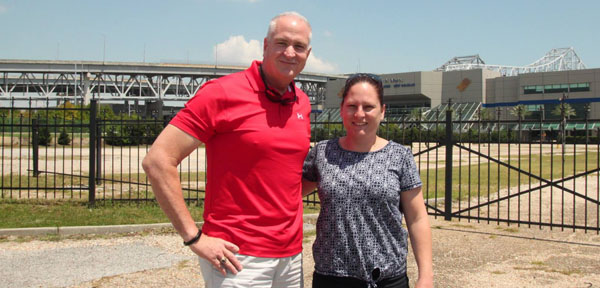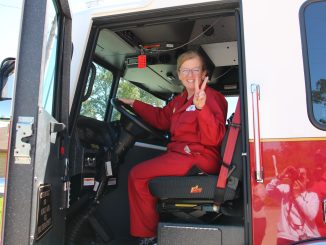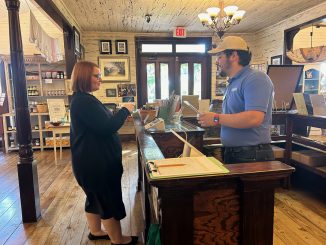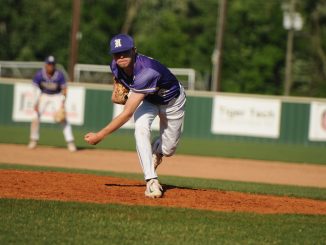
Recount shooting, suffering, express gratitude to St. Charles Parish Sheriff’s Office
Twenty-eight hospital workers and family, along with two Australian tourists, were huddling together near the Ernest Morial Convention Center in the chaos and despair of what was once New Orleans when the St. Charles Parish Sheriff’s Office made a bold move to rescue them.
This was 10 years ago as of Sept. 1 after Hurricane Katrina hammered the city into the costliest natural disaster in U.S. history.
“I feel I owe my life to these guys because if we didn’t get out that night, I hate to think what would have happened,” said Fiona Glendenning of Brisban, Queensland in Australia who recounted her experiences at a recent reunion of survivors at Sheriff Greg Champagne’s residence in Luling.
Glendenning and Alisha Gaye Seidel, her sister-in-law, were in New Orleans a day when they had to wait out Katrina in the Hotel Monteleone in the French Quarter. When the water started rising, they were hastily evacuated and routed to the convention center, but saw it overrun by thousands of people, as well as witnessed a “massive amount of looting.”
“As far as you could see … people,” Glendenning said of the estimated 20,000 people there. “The sight that stays with me today are the babies and older people hot and thirsty. I gave my water to a woman in a wheelchair and would have stayed had it not been for Gaye.”
Instead, they joined an exodus of people walking across the Greater New Orleans Bridge when they heard gun fire and talk of being blocked ahead. They turned around with their luggage (full of precious momentos from their U.S. travels, especially from Disney World).
Inside the convention center, the two Australians met with a group of 28 people with Memorial Hospital in New Orleans, including nurses, aids and family members, lead by Renee Riddick of Luling. Riddick invited the two to stay with them and they were more than willing to stay as they realized what might happen to them otherwise.
Riddick’s group had already encountered people breaking into the hospital pharmacy to steal drugs and, when the hospital could no longer protect its employees and the water started rising, they were evacuated. They were told airboats and buses were coming for them, as well as were instructed to bring the least possible with them. They were instead dropped off at St. Charles Avenue among the hundreds of other people stranded in the city.
Riddick rode the Zoomobile to the convention center.
“It was nuts watching people dropping dead from dehydration,” she said. “Society can break down in three days. It was horrible.”
Talk was rampant about buses coming to rescue them at the convention center, but Riddick heard they had been swamped by panicked people around 2 a.m. The buses did not return and Glendenning saw them parked.
Although her cell phone was dying, Riddick managed to get help to text her husband, David, who was with family in Austin, Texas, on Riddick’s urging. He managed to get a call through to Sheriff Champagne, who recalled getting the first call he’d gotten in three days on his home landline from a distraught man he didn’t know begging for help.
Champagne didn’t question the need for help, but the parish needed it, too. Although not as hard hit as other parishes, he was concerned about dedicating resources outside the parish, as well as heard rumors were rampant about police officers being shot and of people shooting at emergency personnel. They also didn’t have jurisdiction there, as well as worried over the possibility of being overrun by the crowd if they attempted the rescue.
But the sheriff decided they were local people and they should help.
He sent in Capt. Jonathan Walsdorf, Lt. Wayne Lee, Capt. Patrick Yoes and Staff Sgt. Dan Beier of the Louisiana National Guard in an unmarked police car to quietly scout out the convention center area, attempt to locate a New Orleans police officer or National Guardsman to help coordinate the rescue. They also needed to situate the best location to stage the rescue.
“As we slowly drove down Convention Center Boulevard, obscenities of every nature were shouted with some in the crowd aggressively trying to stop the vehicle,” according to Yoes. “Near the intersection of Henderson Street, a group, mostly of women wearing hospital scrubs was observed on the opposite side of the street from the center.”
Walsdorf confirmed it was the group and told them they’d be back in about two hours.
According to Yoes, “During this time we were searching in New Orleans, Sheriff Champagne received several more text messages and calls from Mr. Riddick. He advised that his wife’s text messages were getting desperate and explained her beliefs that they would not survive the night. Lt. Lee and I explained to the sheriff that we were able to drive very close to the convention center and felt very confident we could get a bus there to remove the nurses.”
Champagne agreed.
They rounded up a team of 10 to 12 deputies, lined up a bus and Gary Martin as a driver. They quietly entered the city.
“From bus driver to diversion, from providing cover to tending to medical needs, each had their assignments,” Yoes said. “We walked though the plan in detail, strapped on ballistic vests and riot gear, armed ourselves with enough firepower to take over a small country, loaded onto a yellow school bus and two vehicles, and headed to the Convention Center.”
The bus pulled up at the entrance ramp of U.S. Highway 90 at Tchoupitoulas and Henderson streets. It was pitch black with little moonlight, which allowed them to stealthily move the bus to about 150 yards from the group.
Walsdorf advised the group to slowly walk to the street corner where the bus was waiting.
Riddick recalled how “they rolled up in very big trucks with very big guns and told us to run and follow the lights. They held back throngs of crowds and got us into the bus.”
Glendenning said, as soon as they moved toward the bus, others followed them and they barely made it inside, where Yoes tossed away their luggage to make sure there was room for everyone.
“The mission was successful,” Yoes said. But he later reflected that it was a mistake to toss the luggage. “We were told it could be 50 to 60 people. We tossed the luggage to keep room for the people.”
Inside the bus, Yoes recalled how the group sat quietly, some crying and others hugging each other.
“As we passed out bottled water, I explained to everyone that they had been rescued by the St. Charles Parish Sheriff’s Office and we were on our way back to civilization. With that single explanation, they all began to cheer, tears of fear turned to tears of joy, they smiled as they clapped. The expressions on their faces changed from pure fear to total elation as if there was a flip of a switch.”
Still, Glendenning and others were much more grateful for being rescued, although the trials of Katrina weren’t over. On she and her sister-in-law’s return, they contacted the Australian consulate, which arranged for their flight out of Baton Rouge. Because of airport security, they missed the flight.
The consulate arranged for a hotel room and that night Glendenning called her frantic mother who told her she’d gotten a call on her cell phone (left in the luggage) by a stranger who said she was dead. By then it was Father’s day so Glendenning also called her father, who told her it was the best Father’s Day he’d ever had to know she was alive.
Riddick’s group was taken to St. Charles Parish Hospital where she suffered from panic attacks when separated from the group, worries about having food and being separated from her family again. Both she and Glendenning have dealt with PTSD since that time and have seen therapists to deal with lingering anxieties from their experiences.
But both also say they were fortunate to see the many good people who help save their lives.
Glendenning returned to New Orleans for the 10th anniversary of Hurricane Katrina and finally got the city tour she missed because of the storm. She and Yoes returned to where the group was rescued.
Riddick is just happy to be in a parish that cares about its people.
“I love St. Charles Parish,” she said. “To do what they did as a parish, I just can’t thank the police department and all the people who got it together enough. We have a pretty cool parish.”




Be the first to comment